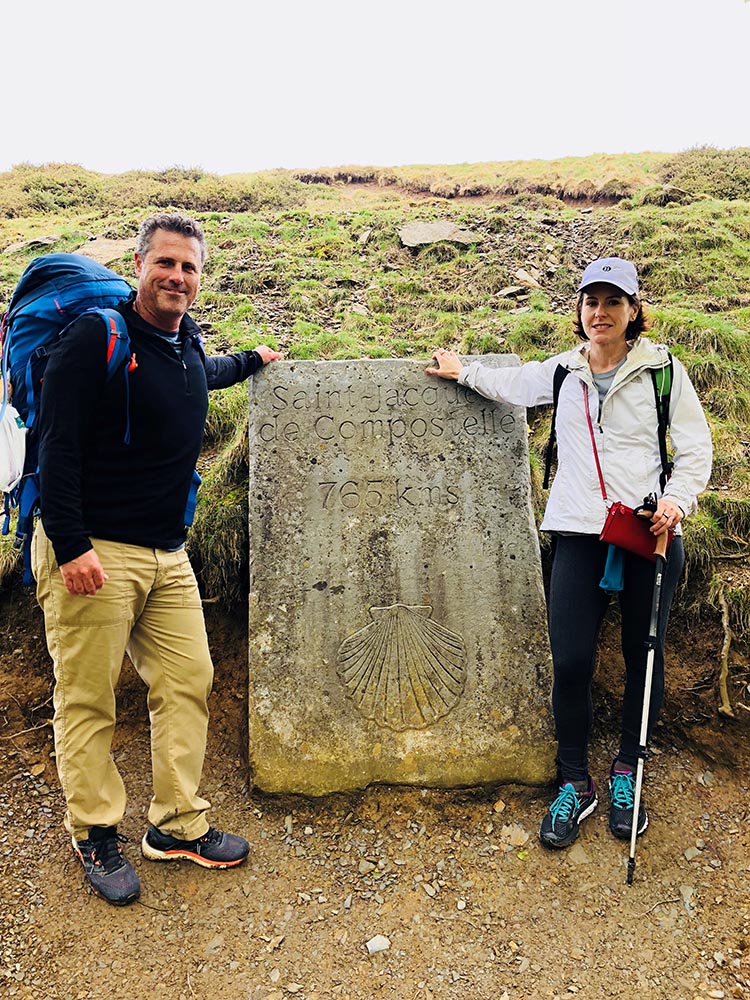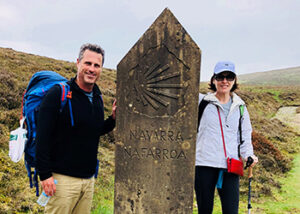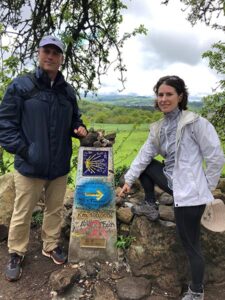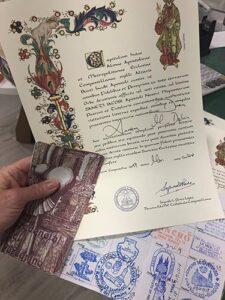Finding Wellness Along “The Way”
 The competing demands of managing a legal practice, parenting teenagers, serving as a support to family members and undertaking volunteer work are often overwhelming and exhausting. While a great sense of satisfaction is derived from the time, effort and care devoted to family, community and professional endeavors, when not counter-balanced by acts of self-care, juggling these commitments can result in feeling unbalanced and depleted. I found myself in such a state as my 50th birthday approached, acute back pain alerting me that I was buckling under the strain.
The competing demands of managing a legal practice, parenting teenagers, serving as a support to family members and undertaking volunteer work are often overwhelming and exhausting. While a great sense of satisfaction is derived from the time, effort and care devoted to family, community and professional endeavors, when not counter-balanced by acts of self-care, juggling these commitments can result in feeling unbalanced and depleted. I found myself in such a state as my 50th birthday approached, acute back pain alerting me that I was buckling under the strain.
Around that time, I started hearing from several separate sources about the Camino de Santiago (the Way of Saint James), a network of medieval hiking trails stretching across Europe and converging in Santiago de Compostela in northwestern Spain. A client mentioned that he had recently returned from a transformative 6-week backpacking trip on the Camino, a gift to himself after surviving cancer. A few months later, a couple with whom I volunteer at the Historical Society told me they were planning to hike the last 100 kilometers of the Camino. After watching “The Way,” a Martin Sheen movie about the Camino de Santiago, I decided to commemorate my milestone birthday by embarking with my brother, Michael, on my own month-long Camino in search of wellness.
Thousands of pilgrims from across the world are drawn to the Camino de Santiago each year, seeking to complete the arduous trek, by foot, bicycle or horseback. Some pilgrims view the Camino as a way to challenge their physical limits by hiking hundreds of kilometers over steep terrain and through adverse weather conditions. For others, it serves as a way to disconnect from the usual stresses of daily life, focusing instead on completing each day’s 15-mile trek immersed in the beauty of the mountains, quaint villages and impressive cities. The Camino is as much a spiritual inner journey as an outward physical one.
Of the several routes in the Santiago network of trails, I chose the popular Camino Frances (the “French Way”), an 850-kilometer stretch starting in a charming village in the French Pyrenees. On the first morning, brimming with anticipation, I registered my journey at the pilgrims’ office by having my pilgrimage passport (the Credencial) stamped with the start date, and set out on the climb over the majestic Roncevaux Pass bordering France and Spain. Along the Camino, I collected stamps in my Credencial chronicling my journey, each a unique imprint bearing the name of a bar, restaurant or albergue (inn) where I ate or slept.
an 850-kilometer stretch starting in a charming village in the French Pyrenees. On the first morning, brimming with anticipation, I registered my journey at the pilgrims’ office by having my pilgrimage passport (the Credencial) stamped with the start date, and set out on the climb over the majestic Roncevaux Pass bordering France and Spain. Along the Camino, I collected stamps in my Credencial chronicling my journey, each a unique imprint bearing the name of a bar, restaurant or albergue (inn) where I ate or slept.
Each day the Camino delivered a different landscape and new companions with whom to share the day’s hike. Over the course of the month, Michael and I walked with dozens of pilgrims from all over the globe. Sometimes, the entire day or even a stretch of days were passed in the company of the same group of travelers. Other days, the hike was shared with someone for only a few hours. Frequently, we walked alone.
It is a Camino tradition to collect pebbles along The Way, each representing a particular earthly struggle and, as it is clenched in the pilgrim’s hand, to transfer onto the rock the weight of the burden embodied by that stone. The long route is periodically marked with monumental markers bearing a scallop shell, the emblem of Saint James. After contemplating burdens along the journey, pilgrims release their worries by placing their pebbles atop these iconic markers. Stones representing particularly significant burdens are carried for longer stretches of the Camino and released at the base of the Cruz de Ferro, a towering iron cross sitting atop a mound of castoff rocks at the highest point of the Camino Frances in the Cantabrian Mountains.
I hiked with travelers varying greatly in age and life circumstances. Many were free with their conversation, unburdening themselves by baring their souls to a stranger they would likely never see again. Opening up to other pilgrims about the burdens represented by the worry stones and listening to them without prejudices or complexes was therapeutic.
Ascending the Pyrenees, we hiked with Australian sisters who were striving to fortify their bond before one  married and the other started her career as a police officer. In Pamplona we hurried to keep pace with a young German guy, who was trying to decide whether to continue his studies or start working. Near the city of Leon, I was pleased to speak Italian with a group of plucky 40-something moms from the Veneto seeking to escape the demands of their ordinary lives and improve their fitness. One of them, Paola, struggled to keep up with her friends, looking exhausted. I carried Paola’s pack for a part of that day’s journey and was rewarded by her warm smile. One memorable “therapy session” resulted from conversation with a woman who confessed her sadness over infertility, as I shared my own experience with her. Toward the end of the month, dear friends from Madrid joined us. Hiking together, we delighted in memories of our youthful days galivanting in the Spanish capital.
married and the other started her career as a police officer. In Pamplona we hurried to keep pace with a young German guy, who was trying to decide whether to continue his studies or start working. Near the city of Leon, I was pleased to speak Italian with a group of plucky 40-something moms from the Veneto seeking to escape the demands of their ordinary lives and improve their fitness. One of them, Paola, struggled to keep up with her friends, looking exhausted. I carried Paola’s pack for a part of that day’s journey and was rewarded by her warm smile. One memorable “therapy session” resulted from conversation with a woman who confessed her sadness over infertility, as I shared my own experience with her. Toward the end of the month, dear friends from Madrid joined us. Hiking together, we delighted in memories of our youthful days galivanting in the Spanish capital.
At the outset, the long voyage seemed dauntingly unconquerable. However, upon reaching the shell emblazed marker that indicates the last 100 kilometers, I experienced a kind of dissonance. I felt excited about finishing the epic trek and, simultaneously, melancholy that the journey would end too soon. On the last morning, I reached the hilltop point at which several Santiago trails converge with the Camino Frances. Taking in the sight of my ultimate destination– the magnificent bell towers of Santiago cathedral – I felt at peace.
 Descending into the cathedral plaza, exhausted travelers smiled, some cried and embraced as the sound of Galician bagpipes filled the air. I tendered my Credencial to the pilgrim’s office where the stamps were tallied ensuring I had completed sufficient mileage to receive the Compostela, a beautifully adorned certificate baring my name in Latin calligraphy. I then joined hundreds of travelers as they filled the pews and spilled onto the cathedral floor for the pilgrims’ mass. Organ music played while grey plumes of scented vapor spewed from the massive Botafumeiro (incense burner) that swayed overhead, a medieval practice to mitigate the pestilence of the pilgrims!
Descending into the cathedral plaza, exhausted travelers smiled, some cried and embraced as the sound of Galician bagpipes filled the air. I tendered my Credencial to the pilgrim’s office where the stamps were tallied ensuring I had completed sufficient mileage to receive the Compostela, a beautifully adorned certificate baring my name in Latin calligraphy. I then joined hundreds of travelers as they filled the pews and spilled onto the cathedral floor for the pilgrims’ mass. Organ music played while grey plumes of scented vapor spewed from the massive Botafumeiro (incense burner) that swayed overhead, a medieval practice to mitigate the pestilence of the pilgrims!
The physical accomplishment, self-reflection, and recovery of lost time with my brother and Spanish friends contributed to the wellness that I found on The Way. I returned to California feeling rejuvenated, grounded and grateful – in much stronger condition to meet life’s personal and professional demands.